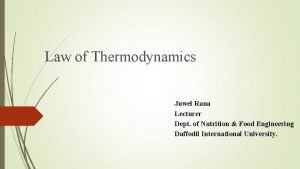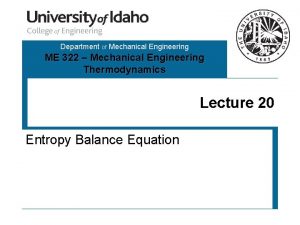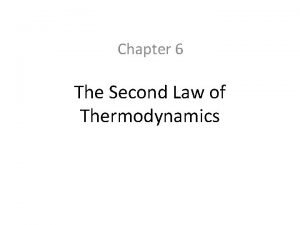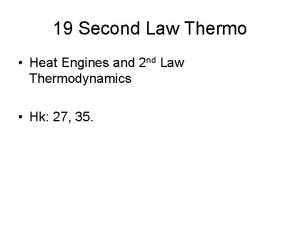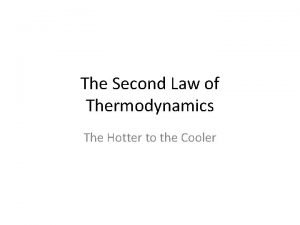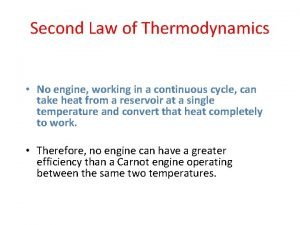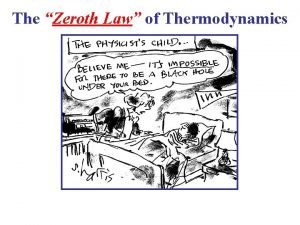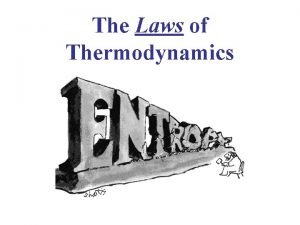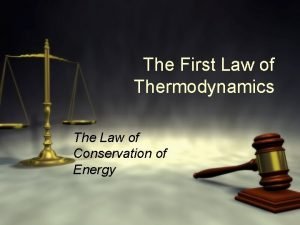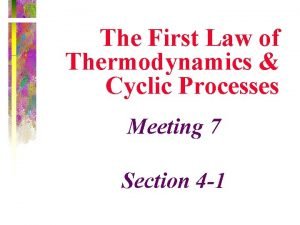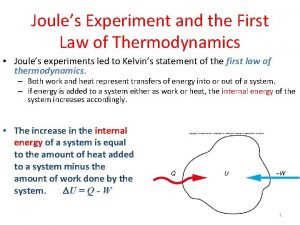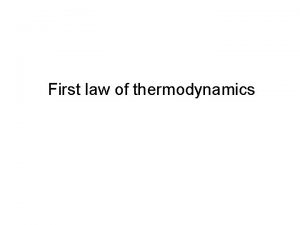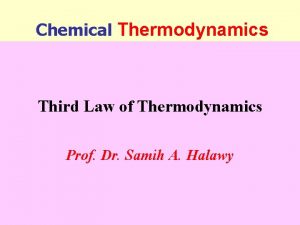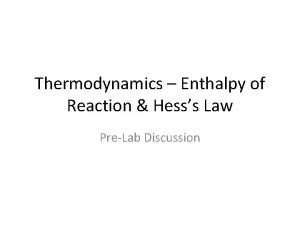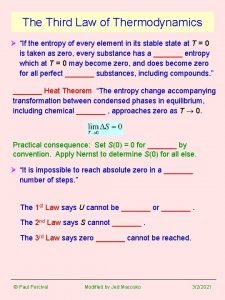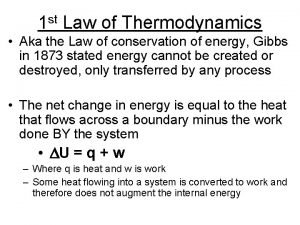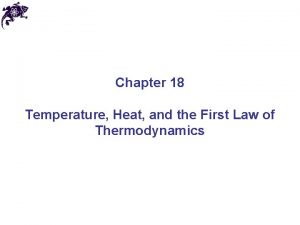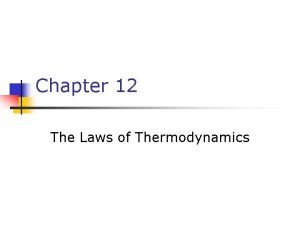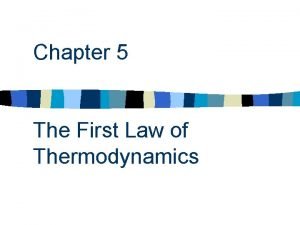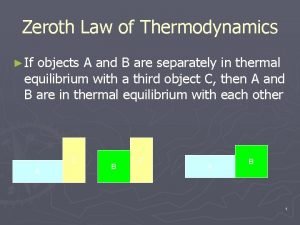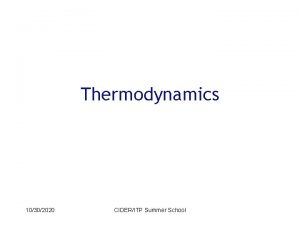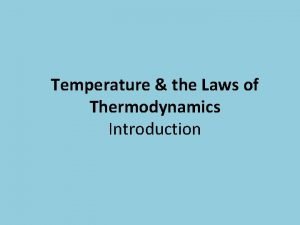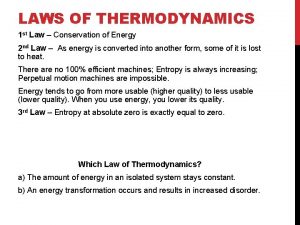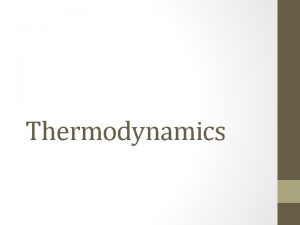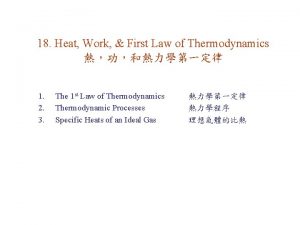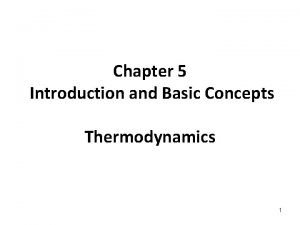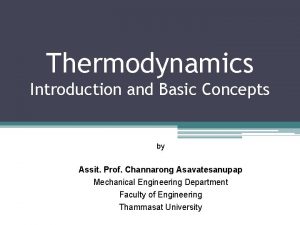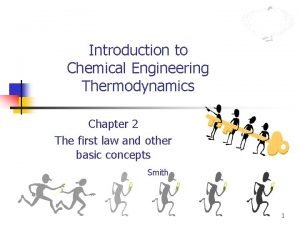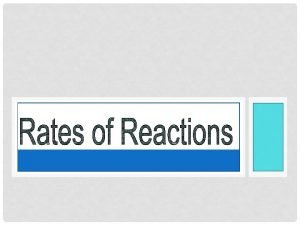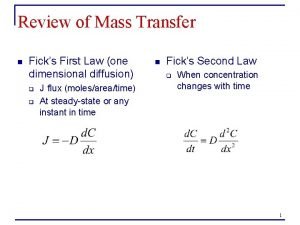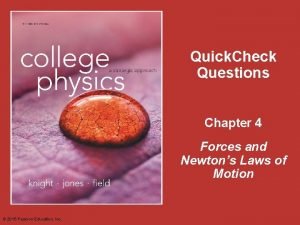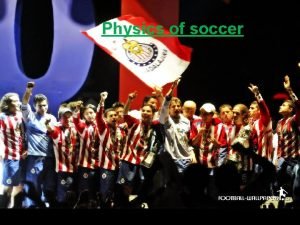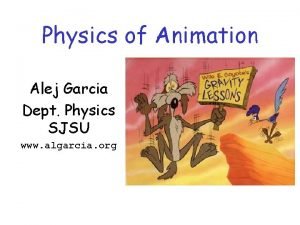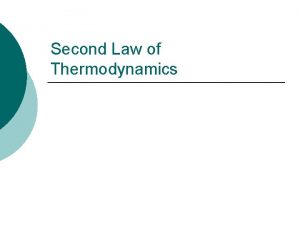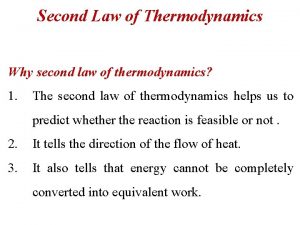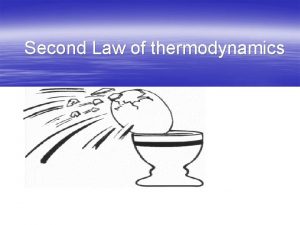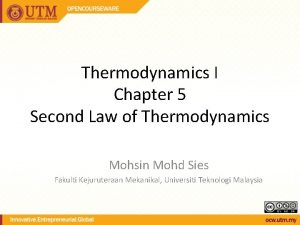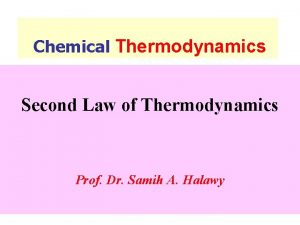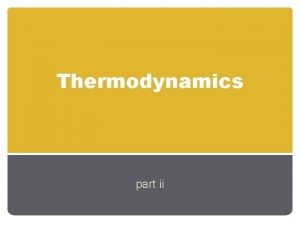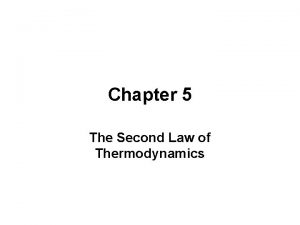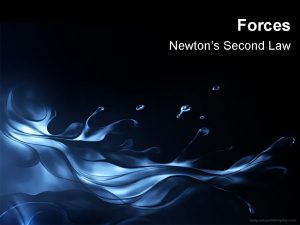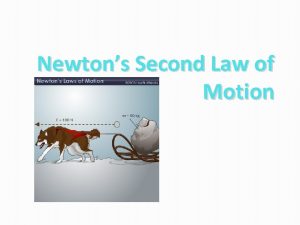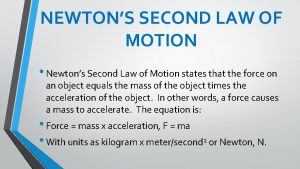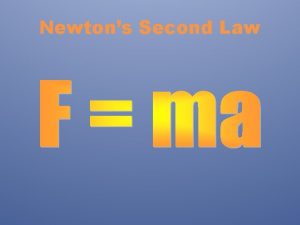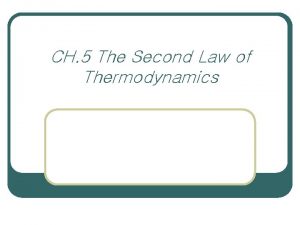THERMODYNAMICS THE SECOND LAW OF THERMODYNAMICS INTRODUCTION TO











































- Slides: 43

THERMODYNAMICS THE SECOND LAW OF THERMODYNAMICS

INTRODUCTION TO THE SECOND LAW Transferring heat to a wire will not generate electricity. These processes cannot occur even though they are not in violation of the first law. Transferring heat to a paddle wheel will not cause it to rotate. 2

Processes occur in a certain direction, and not in the reverse direction. A process must satisfy both the first and second laws of thermodynamics to proceed. MAJOR USES OF THE SECOND LAW 1. The second law may be used to identify the direction of processes. 2. The second law also asserts that energy has quality as well as quantity. The first law is concerned with the quantity of energy and the transformations of energy from one form to another with no regard to its quality. The second law provides the necessary means to determine the quality as well as the degree of degradation of energy during a process. 3. The second law of thermodynamics is also used in determining theoretical limits for the performance of commonly used engineering systems, such as heat engines and refrigerators, as well as predicting the degree of completion of chemical reactions. 3

THERMAL ENERGY RESERVOIRS • • A hypothetical body with a relatively large thermal energy capacity (mass x specific heat) that can supply or absorb finite amounts of heat without undergoing any change in temperature is called a thermal energy reservoir, or just a reservoir. In practice, large bodies of water such as oceans, lakes, and rivers as well as the atmospheric air can be modeled accurately as thermal energy reservoirs because of their large thermal energy storage capabilities or thermal masses. A source supplies energy in the form of heat, and a sink absorbs it. 4

HEAT ENGINES Work can always be converted to heat directly and completely, but the reverse is not true. A device is needed. Part of the heat received by a heat engine is converted to work, while the rest is rejected to a sink. The devices that convert heat to work. 1. They receive heat from a hightemperature source (solar energy, oil furnace, nuclear reactor, etc. ). 2. They convert part of this heat to work (usually in the form of a rotating shaft. ) 3. They reject the remaining waste heat to a low-temperature sink (the atmosphere, rivers, etc. ). 4. They operate on a cycle. Heat engines and other cyclic devices usually involve a fluid to and from which heat is transferred while undergoing a cycle. This fluid is called the working fluid. 5

A steam power plant A portion of the work output of a heat engine is consumed internally to maintain continuous operation. 6

Thermal efficiency Is a measure of how efficiently a heat engine converts the heat that it receives to work. Some heat engines perform better than others (convert more of the heat they receive to work). Even the most efficient heat engines reject almost one-half of the energy they receive as waste heat. 7

Thermal efficiency Qout = Magnitude of the energy wasted, ≠ 0. Qin = Magnitude of the input energy. QH = Magnitude of heat transfer between the cyclic device and the high temperature medium at temperature, TH. QL = Magnitude of heat transfer between the cyclic device and the lower temperature medium at temperature, TL. 8

Example 1 A heat engine has a total heat input of 1. 3 k. J and a thermal efficiency of 35%. How much work will it produce? Solution: 9

Can we save Qout? A heat-engine cycle cannot be completed without rejecting some heat to a low-temperature sink. Every heat engine must waste some energy by transferring it to a low-temperature reservoir in order to complete the cycle, even under idealized conditions. In a steam power plant, the condenser is the device where large quantities of waste heat is rejected to rivers, lakes, or the atmosphere. Can we not just take the condenser out of the plant and save all that waste energy? The answer is, unfortunately, a firm no for the simple reason that without a heat rejection process in a condenser, the cycle cannot be completed. 10

Example 2 A steam power plant with a power output of 150 MW consumes coal at a rate of 60 tons/h. If the heating value of coal is 30, 000 k. J/kg, determine the overall efficiency of this plant. The heating value of coal, , is given to be 30, 000 k. J/kg. Rate of consumption, , is 60 tons/h, which is equal to 60, 000 kg/h. The rate of heat supply to this power plant is 60 t/h coal Furnace HE 150 MW Then thermal efficiency of the plant becomes sink 11

The Second Law of Thermodynamics: Kelvin–Planck Statement It is impossible for any device that operates on a cycle to receive heat from a single reservoir and produce a net amount of work. No heat engine can have a thermal efficiency of 100 percent, or as for a power plant to operate, the working fluid must exchange heat with the environment as well as the furnace. The impossibility of having a 100% efficient heat engine is not due to friction or other dissipative effects. It is a limitation that applies to both the idealized and the actual heat engines. A heat engine that violates the Kelvin–Planck statement of the second law. 12

REFRIGERATORS AND HEAT PUMPS Basic components of a refrigeration system and typical operating conditions. • The transfer of heat from a lowtemperature medium to a hightemperature one requires special devices called refrigerators. • Refrigerators, like heat engines, are cyclic devices. • The working fluid used in the refrigeration cycle is called a refrigerant. • The most frequently used refrigeration cycle is the vaporcompression refrigeration cycle. In a household refrigerator, the freezer compartment where heat is absorbed by the refrigerant serves as the evaporator, and the coils usually behind the refrigerator where heat is dissipated to the kitchen air serve as the condenser. 13

Po. O: Refrigerator § § § Consist of 4 main component: compressor, condenser, expansion valve, evaporator. The refrigerant enters the compressor as a vapor and compressed to the condenser pressure. It leaves the compressor at a relatively high temperature and cools down and condenses as it flow through the coils of the condenser by rejecting heat the surrounding medium. It then enters capillary tube where its pressure and temperature drops drastically due to the throttling effect. The low-temperature refrigerant then enters the evaporator, where it evaporates by absorbing heat from the refrigerated space. The cycle is complete as the refrigerant leaves the evaporator and reenters the compressor. 14

Coefficient of Performance The efficiency of a refrigerator is expressed in terms of the coefficient of performance (COP). The objective of a refrigerator is to remove heat (QL) from the refrigerated space. The objective of a refrigerator is to remove QL from the cooled space. Can the value of COPR be greater than unity? 15

The objective of a heat pump is to supply heat QH into the warmer space. Heat Pumps The work supplied to a heat pump is used to extract energy from the cold outdoors and carry it into the warm indoors. Can the value of COPHP be lower than unity? What does COPHP=1 represent? for fixed values of QL and QH 16

• • When installed backward, • an air conditioner functions as a heat pump. Most heat pumps in operation today have a seasonally averaged COP of 2 to 3. Most existing heat pumps use the cold outside air as the heat source in winter (air-source HP). In cold climates their efficiency drops considerably when temperatures are below the freezing point. In such cases, geothermal (ground-source) HP that use the ground as the heat source can be used. Such heat pumps are more expensive to install, but they are also more efficient. Air conditioners are basically refrigerators whose refrigerated space is a room or a building instead of the food compartment. The COP of a refrigerator decreases with decreasing refrigeration temperature. Therefore, it is not economical to refrigerate to a lower temperature than needed. Energy efficiency rating (EER): The amount of heat removed from the cooled space in Btu’s for 1 Wh (watthour) of electricity consumed. 17

The Second Law of Thermodynamics: Clasius Statement It is impossible to construct a device that operates in a cycle and produces no effect other than the transfer of heat from a lower-temperature body to a higher-temperature body. It states that a refrigerator cannot operate unless its compressor is driven by an external power source, such as an electric motor. This way, the net effect on the surroundings involves the consumption of some energy in the form of work, in addition to the transfer of heat from a colder body to a warmer one. To date, no experiment has been conducted that contradicts the second law, and this should be taken as sufficient proof of its validity. A refrigerator that violates the Clausius statement of the second law. 18

Equivalence of the Two Statements Proof that the violation of the Kelvin–Planck statement leads to the violation of the Clausius statement. The Kelvin–Planck and the Clausius statements are equivalent in their consequences, and either statement can be used as the expression of the second law of thermodynamics. Any device that violates the Kelvin–Planck statement also violates the Clausius statement, and vice versa. 19

PERPETUAL-MOTION MACHINES A perpetual-motion machine that violates the first law (PMM 1). A perpetual-motion machine that violates the second law of thermodynamics (PMM 2). Perpetual-motion machine: Any device that violates the first or the second law. A device that violates the first law (by creating energy) is called a PMM 1. A device that violates the second law is called a PMM 2. Despite numerous attempts, no perpetual-motion machine is known to have worked. If something sounds too good to be true, it probably is. 20

REVERSIBLE AND IRREVERSIBLE PROCESSES Reversible process: A process that can be reversed without leaving any trace on the surroundings. Irreversible process: A process that is not reversible. • • All the processes occurring in nature are irreversible. Why are we interested in reversible processes? (1) they are easy to analyze and (2) they serve as idealized models (theoretical limits) to which actual processes can be compared. Some processes are more irreversible than others. Reversible processes deliver the most and consume the least work. Two familiar reversible processes. 21

• • Friction renders a process irreversible. • The factors that cause a process to be irreversible are called irreversibilities. They include friction, unrestrained expansion, mixing of two fluids, heat transfer across a finite temperature difference, electric resistance, inelastic deformation of solids, and chemical reactions. The presence of any of these effects renders a process irreversible. Irreversibilities (a) Heat transfer through a temperature difference is irreversible, and (b) the reverse process is impossible. Irreversible compression and expansion processes. 22

Internally and Externally Reversible Processes • Internally reversible process: If no irreversibilities occur within the boundaries of the system during the process. • Externally reversible: If no irreversibilities occur outside the system boundaries. • Totally reversible process: It involves no irreversibilities within the system or its surroundings. • A totally reversible process involves no heat transfer through a finite temperature difference, no nonquasi-equilibrium changes, and no friction or other dissipative effects. 23

THE CARNOT CYCLE • The Carnot cycle is a cycle composed of the totally reversible processes of isentropic compression and expansion and isothermal heat addition and rejection. • Proposed by French engineer, Sadi Carnot. • Consist of 4 processes, and can be executed either in a closed or a steadyflow system. • Can be represent by a P-V diagram. (1 -2 -3 -4 -1) • The area enclosed by the path of the cycle is the represent by the net work done during the cycle. Reversible Isothermal Expansion (process 1 -2, TH = constant) Reversible Adiabatic Expansion (process 2 -3, temperature drops from TH to TL) Reversible Isothermal Compression (process 3 -4, TL = constant) Reversible Adiabatic Compression (process 4 -1, temperature rises from TL to TH) 24

THE CARNOT PRINCIPLES 1. The efficiency of an irreversible heat engine is always less than the efficiency of a reversible one operating between the same two reservoirs. 2. The efficiencies of all reversible heat engines operating between the same two reservoirs are the same. 25

Reversible Isothermal Expansion (1 -2) • Initially the gas temperature is TH and cylinder head is close contact to the heat source. Gas is allowed to expand slowly, doing work to the surrounding. The temperature of the gas decrease. As soon as the temperature drops by an infinitesimal amount d. T, some heat is transferred from the reservoir to the gas, keeping it constant at TH. The process continues until the piston reach position 2. • • • Reversible Adiabatic Expansion (2 -3) • • • The reservoir that was in contact with the cylinder head is removed and replaced by insulation so that the system become adiabatic. The gas continues to expand slowly, doing work on the surrounding until the temperature drops to TL. (position 3) The piston is assumed to be frictionless and the process to be quasi-equilibrium, so the process is reversible as well as adiabatic. 26

Reversible Isothermal Compression (3 -4) • • The temperature at this state is constant, TL The insulation at the cylinder head is removed and replaced by a sink at temperature TL. The piston pushed inward by an external force, doing work on the gas. The temperature tends to rise. But as soon as the temperature rises by infinitesimal amount of d. T, the heat is transferred to the sink, and the temperature drops to TL. The temperature then remains constant at TL. The process continues until the piston reached state 4. The amount of the heat rejected from the gas doing this process is QL. • • Reversible Adiabatic Compression (4 -1) • • • The low temperature reservoir is removed, the insulation is putted back to the cylinder head. The gas is compressed in reversible manner, and return to its initial state ( state 1). The temperature rises to TH, during this reversible adiabatic process. 27

P-V diagram of the Carnot cycle. P-V diagram of the reversed Carnot cycle. The Reversed Carnot Cycle The Carnot heat-engine cycle is a totally reversible cycle. Therefore, all the processes that comprise it can be reversed, in which case it becomes the Carnot refrigeration cycle. 28

THE THERMODYNAMIC TEMPERATURE SCALE A temperature scale that is independent of the properties of the substances that are used to measure temperature is called a thermodynamic temperature scale. Such a temperature scale offers great conveniences in thermodynamic calculations. The efficiency of a reversible engine is independent of the working fluid and its properties, the way the cycle is executed, or type of reversible engine used. The arrangement of heat engines used to develop thermodynamic temperature scale. 29

This temperature scale is called the Kelvin scale, and the temperatures on this scale are called absolute temperatures. For reversible cycles, the heat transfer ratio QH /QL can be replaced by the absolute temperature ratio TH /TL. A conceptual experimental setup to determine thermodynamic temperatures on the Kelvin scale by measuring heat transfers QH and QL. 30

THE CARNOT HEAT ENGINE Hypothetical heat engine that operates on reverse Carnot cycle. The Carnot heat engine is the most efficient of all heat engines operating between the same high- and low-temperature reservoirs. Any heat engine No heat engine can have a higher efficiency than a reversible heat engine operating between the same high- and low -temperature reservoirs. Carnot heat engine 31

THE CARNOT REFRIGERATOR AND HEAT PUMP Any refrigerator or heat pump Carnot refrigerator or heat pump No refrigerator can have a higher COP than a reversible refrigerator operating between the same temperature limits. 32

ENTROPY entropy is a measure of the amount of energy which does no work during energy conversions macroscopic property of a thermodynamic system that is a measure of the microscopic disorder within the system

Clausius Inequality 34

ENTROPY Clasius inequality Formal definition of entropy The system considered in the development of the Clausius inequality. The equality in the Clausius inequality holds for totally or just internally reversible cycles and the inequality for the irreversible ones. 35

A quantity whose cyclic integral is zero (i. e. , a property like volume) Entropy is an extensive property of a system. The net change in volume (a property) during a cycle is always zero. A Special Case: Internally Reversible The entropy change between two specified states is the same whether the process is reversible or irreversible. Isothermal Heat Transfer Processes This equation is particularly useful for determining the entropy changes of thermal energy reservoirs. 36

Example Heat is transferred at a rate of 2 k. W from a hot reservoir at 800 K to a cold reservoir at 300 K. Calculate the rate at which the entropy of the two reservoir change and determine the second law is satisfied. Heat is transferred from a hot reservoir to a cold reservoir. The entropy change of the two reservoirs is to be calculated and it is to be determined if the second law is satisfied. The rate of entropy change of everything involved in this transfer of heat is given by TH Since this rate is positive (i. e. , the entropy increases as time passes), this transfer of heat is possible. 2 k. W TL 37

THE INCREASE OF ENTROPY PRINCIPLE The equality holds for an internally reversible process and the inequality for an irreversible process. A cycle composed of a reversible and an irreversible process. Some entropy is generated or created during an irreversible process, and this generation is due entirely to the presence of irreversibilities. The entropy generation Sgen is always a positive quantity or zero. Can the entropy of a system during a process decrease? 38

The entropy change of an isolated system is the sum of the entropy changes of its components, and is never less than zero. A system and its surroundings form an isolated system. The increase of entropy principle 39

Some Remarks about Entropy The entropy change of a system can be negative, but the entropy generation cannot. 1. Processes can occur in a certain direction only, not in any direction. A process must proceed in the direction that complies with the increase of entropy principle, that is, Sgen ≥ 0. A process that violates this principle is impossible. 2. Entropy is a nonconserved property, and there is no such thing as the conservation of entropy principle. Entropy is conserved during the idealized reversible processes only and increases during all actual processes. 3. The performance of engineering systems is degraded by the presence of irreversibilities, and entropy generation is a measure of the magnitudes of the irreversibilities during that process. It is also used to establish criteria for the performance of engineering devices. 40

Example A rigid tank contains an ideal gas at 40 degree Celsius is being stirred by a paddle wheel. The paddle wheel does 200 k. J of work on the ideal gas. It is observed that the temperature of the ideal gas remains constant during this process as a result of heat transfer between the system and the surroundings at 30 degree Celsius. Determine the entropy change of the ideal gas. A rigid tank contains an ideal gas that is being stirred by a paddle wheel. The temperature of the gas remains constant as a result of heat transfer out. The entropy change of the gas is to be determined. The gas in the tank is given to be an ideal gas. The temperature and the specific volume of the gas remain constant during this process. Therefore, the initial and the final states of the gas are the same. Then s 2 = s 1 since entropy is a property. Therefore, IDEAL GAS 40 C 200 k. J Heat 30 C 41

ENTROPY BALANCE “The entropy change of a system during a process is equal to the net entropy transfer through the system boundary and the entropy generated within the system” Entropy Change of a System, ∆Ssystem Energy and entropy balances for a system. 42

Entropy Generation, Sgen Mechanisms of entropy transfer for a general system. Entropy generation outside system boundaries can be accounted for by writing an entropy balance on an extended system that includes the system and its immediate surroundings. 43
 Newton's first law and second law and third law
Newton's first law and second law and third law Newton's first law and second law and third law
Newton's first law and second law and third law Entropy change formula
Entropy change formula State second law of thermodynamics
State second law of thermodynamics What is second law of thermodynamics
What is second law of thermodynamics Second law of thermodynamics
Second law of thermodynamics 2nd law of thermodynamics
2nd law of thermodynamics 2nd law of thermodynamics
2nd law of thermodynamics Second law of thermodynamics
Second law of thermodynamics 186 282 miles per second into meters per second
186 282 miles per second into meters per second V=k/p
V=k/p Avogadro's law constants
Avogadro's law constants Usuf thermodynamics
Usuf thermodynamics Zeroth law of thermo
Zeroth law of thermo Newtons third law of thermodynamics
Newtons third law of thermodynamics Third law of thermodynamics
Third law of thermodynamics Isobaric process formula
Isobaric process formula First law of thermodynamics for cyclic process
First law of thermodynamics for cyclic process Joules experiment
Joules experiment Quasi static process
Quasi static process First law of thermodynamics for steady state flow process
First law of thermodynamics for steady state flow process What are the laws of thermodynamics
What are the laws of thermodynamics Thermodynamics enthalpy of reaction and hess's law
Thermodynamics enthalpy of reaction and hess's law Third law of thermodynamics is depend on
Third law of thermodynamics is depend on 1st law of thermodynamics
1st law of thermodynamics First law of thermodynamics sign convention
First law of thermodynamics sign convention 1st law of thermodynamics
1st law of thermodynamics 1st law of thermodynamics
1st law of thermodynamics Enthalpy vs internal energy
Enthalpy vs internal energy Zeroth law of thermodynamics
Zeroth law of thermodynamics Free energy
Free energy Zeroth law of thermodynamics
Zeroth law of thermodynamics Laws of thermodybamics
Laws of thermodybamics Frist law of thermodynamics
Frist law of thermodynamics First law of thermodynamics for ideal gas
First law of thermodynamics for ideal gas Introduction and basic concepts of thermodynamics
Introduction and basic concepts of thermodynamics Thermodynamics introduction and basic concepts
Thermodynamics introduction and basic concepts Thermodynamics chapter 2
Thermodynamics chapter 2 Constant slope
Constant slope Mendel's second law of independent assortment
Mendel's second law of independent assortment Fick's first and second law of diffusion
Fick's first and second law of diffusion Energy of four forces quick check
Energy of four forces quick check Newton's first law in soccer
Newton's first law in soccer Physics sjsu
Physics sjsu



